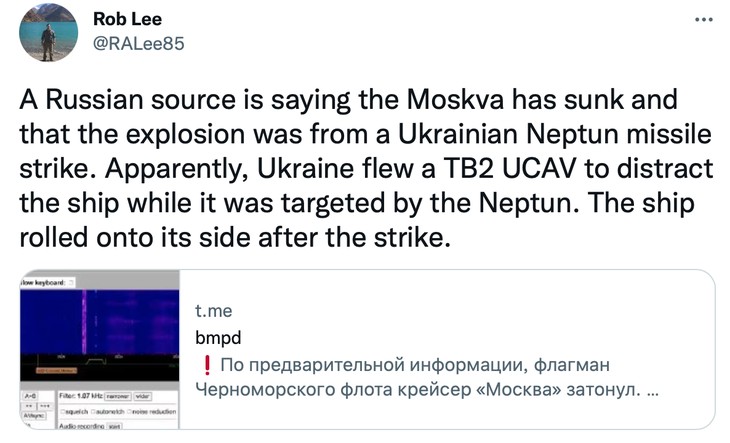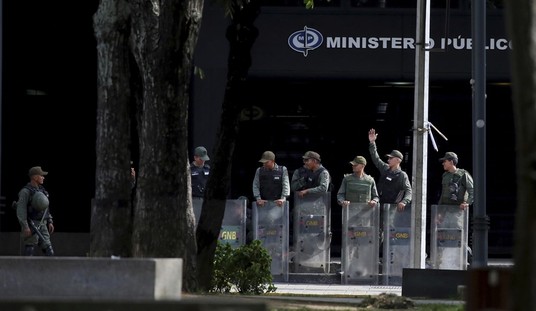UPDATE: The Russian military says the damaged Moskva missile cruiser sank while being towed to a port.
“Abandon ship!” was the last order given aboard Russia’s guided-missile cruiser Moskva on Wednesday.
One report I saw Wednesday night claimed that the ship had rolled over, presumably sinking, but that has yet to be confirmed. Others — including the U.S. government — say the warship remains afloat. We’ll get deeper into the conflicting claims momentarily.
Regardless of whether the Moskva is at the bottom of the Black Sea or the burned husk of what was once the pride of the Black Sea Fleet, the question remains: Did Ukraine do that?
The Kremlin admits that an ammunition explosion caused an onboard fire that “severely damaged” the Moskva, leading to the order to abandon ship.
But there’s good reason to doubt that the fire was an accident.
David Axe reported midday on Wednesday that “multiple Ukrainian government officials claimed Wednesday that a Neptune anti-ship battery, apparently hidden in or around Odessa, scored two hits on Moskva, setting the 612-foot vessel ablaze.”
Ukraine doesn’t possess many Neptune anti-ship missiles — apparently just one battery out of several they’d planned on procuring before the Russian invasion — but the missile is generally well-regarded.
Axe advised readers to “be skeptical” about the claim, and initially, I was.
What caught my eye — or ear, that is — was this audio recording circulating on Twitter of Ukraine soldiers chattering about a pair of successful missile hits on the Moskva.
Looks like the Moskva just got JUSTed too with 2 Ukrainian Neptune anti-ship cruise missiles.
Русский военный корабль, иди на хуй. pic.twitter.com/b2yNg25ILY
— SPITFIRE VA 🇬🇧 (@SPITFIREVA) April 13, 2022
In order to fake this recording, Ukraine would have had to have known about the “accidental fire” before almost anyone else did.
Instead, as the evening wore on I was able to find more detailed accounts that would seem to back up most of Ukraine’s claims.
According to Western sources cited at this Russian-language site (thank goodness for Google Translate, right?) Moskva was 25 miles off of Ukraine’s Snake Island when the attack occurred. That’s well within the Neptune’s 190-mile range.
The Daily Mail reported that the crew was “sitting ducks after sailing in predictable patterns within range of Ukraine’s coastal missile batteries.”
If that seems stupid, remember that the Black Sea Fleet has, since the war started, been keeping itself very visible along Ukraine’s coast. The reason is to maintain the appearance of a possible coastal invasion, tying down Ukrainian troops who could be better used elsewhere.
The Russian Ministry of Defense (same link as above) says that the crew was evacuated to other warships in the area, that the main armaments were not damaged, and that the ship is being towed back to harbor.
They also claim that the fire is “localized” and that the “ammunition explosions have stopped.”
Recommended: What’s Really Going on With CNN+?
Moscow’s claims actually fit with the Neptune’s limited destructive power. The Neptune is designed to destroy ships that displace 5,000 tons or less. A Slava-class cruiser like the Moskva is 12,490 tons. A Neptune or two should be able to damage, but not necessarily sink, a ship of that size.
It might take a short while longer, but Western intel agencies ought to be able to refute or support Moscow’s claims.
The Pentagon disputes the 25-mile range, saying that the Moskva was actually 60 miles offshore. At that distance, it seems even less likely that Ukraine would have known about a shipboard accident in time to fake claims of a successful missile strike.
As of about 10 a.m. Eastern today, Ukraine was claiming that “the Moskva has now started sinking.” There’s no evidence (yet) to back up that claim.
So did Ukraine sink the Moskva? Probably not — or at least not yet. Did they take her out of commission, probably for the duration of the war, or maybe even permanently? By all accounts — except for Russia’s — it certainly looks that way.
With the (re!-)retirement of the last battleships from the U.S. Navy 30 years ago, cruisers (and a couple of battlecruisers) are the largest and most powerful surface combatants still in use by the world’s navies.
Slava-class ships, in terms of size, speed, and armament, are about equivalent to the U.S. Navy’s formidable Ticonderoga-class guided-missile cruisers.
The Russian Navy is a shadow of the former Soviet fleet.
Aside from the two Kirov-class battlecruisers, the Moskva and her two Slava-class sister ships are the most powerful surface combatants in the Russian Navy.
Only one Kirov, the Pyotr Velikiy, is in active service. The Admiral Nakhimov has been undergoing refit since 2006 and was supposed to reenter service this year or next. With sanctions, who knows if her refit will ever be completed.
Of the three Slava cruisers, Marshal Ustinov is active with the Northern Fleet based on the Barents Sea, and the Varyag serves in the Pacific. The Moskva is burning or perhaps sinking.
With one or two missile strikes, Ukraine eliminated the backbone of Russia’s Black Sea Fleet and knocked out a significant fraction of its total naval combat power.
As the wise man said: That’s gotta hurt.











Join the conversation as a VIP Member